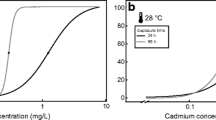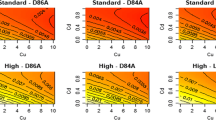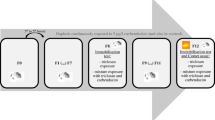Abstract
The joint effect of increasing temperature and pollution on aquatic organisms is important to understand and predict, as a combination of stressors might be more noxious when compared to their individual effects. Our goal was to determine the sensitivity of a model organism (Daphnia spp.) to contaminants at increasing temperatures, allowing prior acclimation of the organisms to the different temperatures. Prior to exposure, two Daphnia genotypes (Daphnia longispina species complex) were acclimated to three temperatures (17, 20, and 23 °C). Afterwards, a crossed design was established using different exposure temperatures and a range of concentrations of two common fungicides (tebuconazole and copper). Daphnia life history parameters were analysed in each temperature × toxicant combination for 21 days. Temperature was the most influencing factor: Daphnia reproduced later and had lower fecundity at 17 °C than at 20 and 23 °C. Both copper and tebuconazole also significantly reduced the fecundity and survival of Daphnia at environmentally-relevant concentrations. Temperature-dependence was found for both toxicants, but the response pattern was endpoint- and genotype-specific. The combination of contaminant and high temperature often had severe effects on survival. However, unlike some literature on the subject, our results do not support the theory that increasing temperatures consistently foment increasing reproductive toxicity. The absence of a clear temperature-dependent toxicity pattern may result from the previous acclimation to the temperature regime. However, a proper framework is lacking to compare such studies and to avoid misleading conclusions for climate change scenarios.




Similar content being viewed by others
References
Antunes SC, Castro BB, Goncalves F (2003) Chronic responses of different clones of Daphnia longispina (field and ephippia) to different food levels. Acta Oecol 24:S325–S332. doi:10.1016/s1146-609x(03)00026-2
Antunes SC, Castro BB, Goncalves F (2004) Effect of food level on the acute and chronic responses of daphnids to lindane. Environ Pollut 127:367–375. doi:10.1016/j.envpol.2003.08.015
Balbus JM, Boxall AB, Fenske R, McKone TE, Zeise L (2013) Implications of global climate change for the assessment and management of human health risks of chemicals in the natural environment. Environ Toxicol Chem 32:62–78. doi:10.1002/etc.2046
Bates B, Kundzewicz Z, Wu S, Palutikof J (2008) Climate change and water: technical paper of the intergovernmental panel on climate change. IPCC Secretariat, Geneva
Berenzen N, Lentzen-Godding A, Probst M, Schulz H, Schulz R, Liess M (2005) A comparison of predicted and measured levels of runoff-related pesticide concentrations in small lowland streams on a landscape level. Chemosphere 58:683–691. doi:10.1016/j.chemosphere.2004.05.009
Bereswill R, Golla B, Streloke M, Schulz R (2012) Entry and toxicity of organic pesticides and copper in vineyard streams: erosion rills jeopardise the efficiency of riparian buffer strips. Agric Ecosyst Environ 146:81–92. doi:10.1016/j.agee.2011.10.010
Bloomfield JP, Williams RJ, Gooddy DC, Cape JN, Guha P (2006) Impacts of climate change on the fate and behaviour of pesticides in surface and groundwater—a UK perspective. Sci Total Environ 369:163–177. doi:10.1016/j.scitotenv.2006.05.019
Boersma M, De Meester L, Spaak P (1999) Environmental stress and local adaptation in Daphnia magna. Limnol Oceanogr 44:393–402
Brown JH, Gillooly JF, Allen AP, Savage VM, West GB (2004) Toward a metabolic theory of ecology. Ecology 85:1771–1789. doi:10.1890/03-9000
Brucet S, Boix D, Quintana XD, Jensen E, Nathansen LW, Trochine C, Meerhoff M, Gascón S, Jeppesen E (2010) Factors influencing zooplankton size structure at contrasting temperatures in coastal shallow lakes: implications for effects of climate change. Limnol Oceanogr 55:1697–1711. doi:10.4319/lo.2010.55.4.1697
Buser CC, Spaak P, Wolinska J (2012) Disease and pollution alter Daphnia taxonomic and clonal structure in experimental assemblages. Freshw Biol 57:1865–1874. doi:10.1111/j.1365-2427.2012.02846.x
Castro BB, Consciência S, Gonçalves F (2007) Life history responses of Daphnia longispina to mosquitofish (Gambusia holbrooki) and pumpkinseed (Lepomis gibbosus) kairomones. Hydrobiologia 594:165–174. doi:10.1007/s10750-007-9074-5
Cerejeira MJ, Viana P, Batista S, Pereira T, Silva E, Valério MJ, Silva A, Ferreira M, Silva-Fernandes AM (2003) Pesticides in Portuguese surface and ground waters. Water Res 37:1055–1063
Chopelet J, Blier PU, Dufresne F (2008) Plasticity of growth rate and metabolism in Daphnia magna populations from different thermal habitats. J Exp Zool Ecol Genet Physiol 309:553–562. doi:10.1002/jez.488
Coors A, De Meester L (2008) Synergistic, antagonistic and additive effects of multiple stressors: predation threat, parasitism and pesticide exposure in Daphnia magna. J Appl Ecol 45:1820–1828. doi:10.1111/j.1365-2664.2008.01566.x
Dang CK, Schindler M, Chauvet E, Gessner MO (2009) Temperature oscillation coupled with fungal community shifts can modulate warming effects on litter decomposition. Ecology 90:122–131. doi:10.1890/07-1974.1
De Meester L, Van Doorslaer W, Geerts A, Orsini L, Stoks R (2011) Thermal genetic adaptation in the water flea Daphnia and its impact: an evolving metacommunity approach. Integr Comp Biol 51:703–718. doi:10.1093/icb/icr027
Engert A, Chakrabarti S, Saul N, Bittner M, Menzel R, Steinberg CEW (2013) Interaction of temperature and an environmental stressor: Moina macrocopa responds with increased body size, increased lifespan, and increased offspring numbers slightly above its temperature optimum. Chemosphere 90:2136–2141. doi:10.1016/j.chemosphere.2012.10.099
Ferreira ALG, Serra P, Soares AMVM, Loureiro S (2010) The influence of natural stressors on the toxicity of nickel to Daphnia magna. Environ Sci Pollut Res 17:1217–1229. doi:10.1007/s11356-010-0298-y
Fischer JM, Olson MH, Williamson CE, Everhart JC, Hogan PJ, Mack JA, Rose KC, Saros JE, Stone JR, Vinebrooke RD (2011) Implications of climate change for Daphnia in alpine lakes: predictions from long-term dynamics, spatial distribution, and a short-term experiment. Hydrobiologia 676:263–277. doi:10.1007/s10750-011-0888-9
Fischer BB, Pomati F, Eggen RIL (2013) The toxicity of chemical pollutants in dynamic natural systems: the challenge of integrating environmental factors and biological complexity. Sci Total Environ 449:253–259. doi:10.1016/j.scitotenv.2013.01.066
Forbes V, Calow P (1999) Is the per capita rate of increase a good measure of population-level effects in ecotoxicology? Environ Toxicol Chem 18:1544–1556
Garric J, Migeon B, Vindimian E (1990) Lethal effects of draining on brown trout. a predictive model based on field and laboratory studies. Water Res 24:59–65. doi:10.1016/0043-1354(90)90065-E
Gouveia C, Liberato M, DaCamara C, Trigo R, Ramos A (2011) Modelling past and future wine production in the Portuguese douro valley. Clim Res 48:349–362. doi:10.3354/cr01006
Green JW (2014) Power and control choice in aquatic experiments with solvents. Ecotoxicol Environ Saf 102:142–146. doi:10.1016/j.ecoenv.2014.01.024
Green J, Wheeler JR (2013) The use of carrier solvents in regulatory aquatic toxicology testing: practical, statistical and regulatory considerations. Aquat Toxicol 144–145:242–249. doi:10.1016/j.aquatox.2013.10.004
Hanazato T (2001) Pesticide effects on freshwater zooplankton: an ecological perspective. Environ Pollut 112:1–10
Heugens EH, Hendriks AJ, Dekker T, van Straalen NM, Admiraal W (2001) A review of the effects of multiple stressors on aquatic organisms and analysis of uncertainty factors for use in risk assessment. Crit Rev Toxicol 31:247–284
Heugens E, Jager T, Creyghton R, Kraak M, Hendriks A, van Straalen N, Admiraal W (2003) Temperature-dependent effects of cadmium on Daphnia magna: accumulation versus sensitivity. Environ Sci Technol 37(10):2145–2151
Heugens E, Tokkie L, Kraak M, Hendriks A, van Straalen N, Admiraal W (2006) Population growth of Daphnia magna under multiple stress conditions: joint effects of temperature, food, and cadmium. Environ Toxicol Chem 25:1399–1407
Holmstrup M, Bindesbøl A-M, Oostingh GJ, Duschl A, Scheil V, Köhler H-R, Loureiro S, Soares AMVM, Ferreira ALG, Kienle C, Gerhardt A, Laskowski R, Kramarz PE, Bayley M, Svendsen C, Spurgeon DJ (2010) Interactions between effects of environmental chemicals and natural stressors: a review. Sci Total Environ 408:3746–3762
IPCC (2014a) Climate change 2014: impacts, adaptation, and vulnerability. Part A: global and sectoral aspects. contribution of working group II to the fifth assessment report of the intergovernmental panel on climate change. Cambridge University, Cambridge
IPCC (2014b) Climate change 2014: synthesis report. contribution of working groups I, II and III to the fifth assessment report of the intergovernmental panel on climate change, Core Writing Team, R.K. Pachauri L.A. Meyer (eds.) IPCC, Geneva
Jansen M, Coors A, Stoks R, De Meester L (2011a) Evolutionary ecotoxicology of pesticide resistance: a case study in Daphnia. Ecotoxicology 20:543–551. doi:10.1007/s10646-011-0627-z
Jansen M, De Meester L, Cielen A, Buser CC, Stoks R (2011b) The interplay of past and current stress exposure on the water flea Daphnia. Funct Ecol 25:974–982. doi:10.1111/j.1365-2435.2011.01869.x
Kegley SE, Hill BR, Orme S, Choi, AH, (2014). PAN Pesticide Database. Pestic. Action Netw., North America Oakland URL http://www.pesticideinfo.org
Kim J, Park J, Kim PG, Lee C, Choi K, Choi K (2010) Implication of global environmental changes on chemical toxicity-effect of water temperature, pH, and ultraviolet B irradiation on acute toxicity of several pharmaceuticals in Daphnia magna. Ecotoxicology 19:662–669. doi:10.1007/s10646-009-0440-0
Knillmann S, Stampfli NC, Noskov YA, Beketov MA, Liess M (2013) Elevated temperature prolongs long-term effects of a pesticide on Daphnia spp. due to altered competition in zooplankton communities. Glob Chang Biol 19:1598–1609. doi:10.1111/gcb.12151
Komárek M, Cadková E, Chrastný V, Bordas F, Bollinger J-C (2010) Contamination of vineyard soils with fungicides: a review of environmental and toxicological aspects. Environ Int 36:138–151. doi:10.1016/j.envint.2009.10.005
Krienitz L, Bock C, Nozaki H, Wolf M (2011) SSU rRNA gene phylogeny of morphospecies affiliated to the bioassay alga “Selenastrum capricornutum” recovered the polyphyletic origin of crescent-shaped chlorophyta1. J Phycol 47:880–893. doi:10.1111/j.1529-8817.2011.01010.x
Lagerspetz KYH, Vainio LA (2006) Thermal behaviour of crustaceans. Biol Rev Camb Philos Soc 81:237–258. doi:10.1017/S1464793105006998
Lampert W (2006) Daphnia: model herbivore, predator and prey. Polish J Ecol 54:607–620
Lewis KA, Tzilivakis J, Warner DJ, Green A (2016) An international database for pesticide risk assessments and management. Hum Ecol Risk Assess 22:1050–1064. doi:10.1080/10807039.2015.1133242
Loureiro C, Castro BB, Pereira JL, Gonçalves F (2011) Performance of standard media in toxicological assessments with Daphnia magna: chelators and ionic composition versus metal toxicity. Ecotoxicology 20:139–148. doi:10.1007/s10646-010-0565-1
Loureiro C, Castro BB, Cuco AP, Pedrosa MA, Gonçalves F (2013) Life-history responses of salinity-tolerant and salinity-sensitive lineages of a stenohaline cladoceran do not confirm clonal differentiation. Hydrobiologia 702:73–82. doi:10.1007/s10750-012-1308-5
Loureiro C, Cuco AP, Claro MT, Santos JI, Pedrosa MA, Gonçalves F, Castro BB (2015) Progressive acclimation alters interaction between salinity and temperature in experimental Daphnia populations. Chemosphere 139:126–132. doi:10.1016/j.chemosphere.2015.05.081
Luoto TP, Nevalainen L (2013) Climate change impacts on zooplankton and benthic communities in Lake Unterer Giglachsee (Niedere Tauern Alps, Austria). Int Rev Hydrobiol 98:80–88. doi:10.1002/iroh.201301461
McCallum H (1999) Rate of increase of a population. In: Population parameters: estimation for ecological models. Blackwell Science Ltd, Oxford. doi:10.1002/9780470757468.ch5
Messiaen M, De Schamphelaere KAC, Muyssen BTA, Janssen CR (2010) The micro-evolutionary potential of Daphnia magna population exposed to temperature and cadmium stress. Ecotoxicol Environ Saf 73:1114–1122. doi:10.1016/j.ecoenv.2010.05.006
Meyer JS, Ingersoll CG, McDonald LL, Boyce MS (1986) Estimating uncertainty in population growth rates: jackknife vs. bootstrap techniques. Ecology 67:1156. doi:10.2307/1938671
Meyer JS, Ingersoll CG, McDonald LL (1987) Sensitivity analysis of population growth rates estimated from cladoceran chronic toxicity tests. Environ Toxicol Chem 6:115–126. doi:10.1002/etc.5620060206
Moe SJ, De Schamphelaere K, Clements WH, Sorensen MT, Van den Brink PJ, Liess M (2013) Combined and interactive effects of global climate change and toxicants on populations and communities. Environ Toxicol Chem 32:49–61. doi:10.1002/etc.2045
Moreira L, (2013). Exportação de nutrientes e pesticidas em áreas vitícolas. Master Thesis, University of Aveiro
Muyssen BTA, Messiaen M, Janssen CR (2010) Combined cadmium and temperature acclimation in Daphnia magna: physiological and sub-cellular effects. Ecotoxicol Environ Saf 73:735–742. doi:10.1016/j.ecoenv.2009.12.018
Neves M, Castro BB, Vidal T, Vieira R, Marques JC, Coutinho JAP, Gonçalves F, Gonçalves AMM (2015) Biochemical and populational responses of an aquatic bioindicator species, Daphnia longispina, to a commercial formulation of a herbicide (Primextra® Gold TZ) and its active ingredient (S-metolachlor). Ecol. Indic. 53:220–230. doi:10.1016/j.ecolind.2015.01.031
Nielsen DL, Brock MA (2009) Modified water regime and salinity as a consequence of climate change: prospects for wetlands of Southern Australia. Clim Change 95:523–533. doi:10.1007/s10584-009-9564-8
Noyes PD, McElwee MK, Miller HD, Clark BW, Van Tiem LA, Walcott KC, Erwin KN, Levin ED (2009) The toxicology of climate change: environmental contaminants in a warming world. Environ Int 35:971–986. doi:10.1016/j.envint.2009.02.006
Ochoa-Acuña HG, Bialkowski W, Yale G, Hahn L (2009) Toxicity of soybean rust fungicides to freshwater algae and Daphnia magna. Ecotoxicology 18:440–446. doi:10.1007/s10646-009-0298-1
OECD 2012. Test No. 211: Daphnia magna reproduction test, OECD guidelines for the testing of chemicals, section 2. OECD. doi:10.1787/9789264185203-en
Paul RJ, Mertenskötter A, Pinkhaus O, Pirow R, Gigengack U, Buchen I, Koch M, Horn W, Zeis B (2012) Seasonal and interannual changes in water temperature affect the genetic structure of a Daphnia assemblage (D. longispina complex) through genotype-specific thermal tolerances. Limnol Oceanogr 57:619–633. doi:10.4319/lo.2012.57.2.0619
Quinn G, Keough MJ (2002) Experimental design and data analysis for biologists. Cambridge University, Cambridge
Rabiet M, Margoum C, Gouy V, Carluer N, Coquery M (2010) Assessing pesticide concentrations and fluxes in the stream of a small vineyard catchment-effect of sampling frequency. Environ Pollut 158:737–748. doi:10.1016/j.envpol.2009.10.014
R Core Team (2014). R: a language and environment for statistical computing. R Foundation for Statistical Computing Vienna http://www.r-project.org/
Ritz C (2010) Toward a unified approach to dose-response modeling in ecotoxicology. Environ Toxicol Chem 29:220–229. doi:10.1002/etc.7
Ritz C, Streibig JC (2005) Bioassay Analysis using R. J Stat Softw 12:1–22
Sancho E, Villarroel MJ, Andreu E, Ferrando MD (2009) Disturbances in energy metabolism of Daphnia magna after exposure to tebuconazole. Chemosphere 74:1171–1178. doi:10.1016/j.chemosphere.2008.11.076
Scherer C, Seeland A, Oehlmann J, Müller R (2013) Interactive effects of xenobiotic, abiotic and biotic stressors on Daphnia pulex–results from a multiple stressor experiment with a fractional multifactorial design. Aquat Toxicol 138–139:105–115. doi:10.1016/j.aquatox.2013.04.014
Seeland A, Oehlmann J, Müller R (2012) Aquatic ecotoxicity of the fungicide pyrimethanil: effect profile under optimal and thermal stress conditions. Environ Pollut 168:161–169. doi:10.1016/j.envpol.2012.04.020
Seeland A, Albrand J, Oehlmann J, Müller R (2013) Life stage-specific effects of the fungicide pyrimethanil and temperature on the snail Physella acuta (Draparnaud, 1805) disclose the pitfalls for the aquatic risk assessment under global climate change. Environ Pollut 174:1–9. doi:10.1016/j.envpol.2012.10.020
Stampfli NC, Knillmann S, Liess M, Beketov MA (2011) Environmental context determines community sensitivity of freshwater zooplankton to a pesticide. Aquat Toxicol 104:116–124. doi:10.1016/j.aquatox.2011.04.004
Stampfli NC, Knillmann S, Liess M, Noskov YA, Schäfer RB, Beketov MA (2013) Two stressors and a community: effects of hydrological disturbance and a toxicant on freshwater zooplankton. Aquat Toxicol 127:9–20. doi:10.1016/j.aquatox.2012.09.003
Tassou KT, Schulz R (2012) Combined effects of temperature and pyriproxyfen stress in a full life-cycle test with Chironomus riparius (Insecta). Environ Toxicol Chem 31:2384–2390. doi:10.1002/etc.1969
Van Doorslaer W, Stoks R, Jeppesen E, De Meester L (2007) Adaptive microevolutionary responses to simulated global warming in Simocephalus vetulus: a mesocosm study. Glob Chang Biol 13:878–886. doi:10.1111/j.1365-2486.2007.01317.x
Van Doorslaer W, Stoks R, Duvivier C, Bednarska A, De Meester L (2009a) Population dynamics determine genetic adaptation to temperature in Daphnia. Evolution 63:1867–1878. doi:10.1111/j.1558-5646.2009.00679.x
Van Doorslaer W, Vanoverbeke J, Duvivier C, Rousseaux S, Jansen M, Jansen B, Feuchtmayr H, Atkinson D, Moss B, Stoks R, De Meester L (2009b) Local adaptation to higher temperatures reduces immigration success of genotypes from a warmer region in the water flea Daphnia. Glob Chang Biol 15:3046–3055. doi:10.1111/j.1365-2486.2009.01980.x
Van Doorslaer W, Stoks R, Swillen I, Feuchtmayr H, Atkinson D, Moss B, De Meester L (2010) Experimental thermal microevolution in community-embedded Daphnia populations. Clim Res 43:81–89. doi:10.3354/cr00894
Wilson RRS, Franklin CCE (2002) Testing the beneficial acclimation hypothesis. Trends Ecol Evol 17:66–70. doi:10.1016/S0169-5347(01)02384-9
Winder M, Schindler D (2004) Climate Change uncouples trophic interactions in an aquatic ecosystem. Ecology 85:2100–2106. doi:10.1890/04-0151
Wojtal-Frankiewicz A (2011) The effects of global warming on Daphnia spp. population dynamics: a review. Aquat Ecol 46:37–53. doi:10.1007/s10452-011-9380-x
Yin M, Laforsch C, Lohr JN, Wolinska J (2011) Predator-induced defense makes Daphnia more vulnerable to parasites. Evolution 65:1482–1488. doi:10.1111/j.1558-5646.2011.01240.x
Zeis B, Maurer J, Pinkhaus O, Bongartz E, Paul RJ (2004) A swimming activity assay shows that the thermal tolerance of Daphnia magna is influenced by temperature acclimation. Can J Zool 82:1605–1613. doi:10.1139/z04-141
Zhang L, Gibble R, Baer KN (2003) The effects of 4-nonylphenol and ethanol on acute toxicity, embryo development, and reproduction in Daphnia magna. Ecotoxicol Environ Saf 55:330–337. doi:10.1016/S0147-6513(02)00081-7
Zubrod JP, Bundschuh M, Schulz R (2010) Effects of subchronic fungicide exposure on the energy processing of Gammarus fossarum (Crustacea; Amphipoda). Ecotoxicol Environ Saf 73:1674–1680. doi:10.1016/j.ecoenv.2010.07.046
Zubrod JP, Baudy P, Schulz R, Bundschuh M (2014) Effects of current-use fungicides and their mixtures on the feeding and survival of the key shredder Gammarus fossarum. Aquat Toxicol 150:133–143. doi:10.1016/j.aquatox.2014.03.002
Acknowledgments
Authors thank Mark Phillipo for linguistic help.
Funding
This work was supported by European funds through COMPETE2020 (European Regional Development Fund) and by national funds through the Portuguese Science Foundation (FCT I.P.) within the strategic programmes UID/AMB/50017/2013 (CESAM) and UID/BIA/04050/2013 (CBMA), as well as by the research project VITAQUA (PTDC/AAC-AMB/112438/2009). Ana P. Cuco and Nelson Abrantes are individual recipients of, respectively, a PhD Grant (SFRH/BD/81661/2011) and a researcher contract (IF/01198/2014) from FCT.
Author information
Authors and Affiliations
Corresponding author
Ethics declarations
Conflict of interest
The authors declare that they have no conflict of interest.
Ethical approval
This study did not involve any research conducted on human participants. No specific permissions were necessary, because the existing legislation on the welfare of experimental animals is not applicable and the study did not involve the collection of endangered or protected species.
Rights and permissions
About this article
Cite this article
Cuco, A.P., Abrantes, N., Gonçalves, F. et al. Toxicity of two fungicides in Daphnia: is it always temperature-dependent?. Ecotoxicology 25, 1376–1389 (2016). https://doi.org/10.1007/s10646-016-1689-8
Accepted:
Published:
Issue Date:
DOI: https://doi.org/10.1007/s10646-016-1689-8




